Armored cars of the Piranyev family. Part III
As mentioned in the previous part of our story, the unexpected popularity of the four-axle armored vehicle of the Piranha family, as a result, affected not only the financial well-being of its developers and manufacturers. Modifications of the original Piranha 8x8 machine were conditionally separated into a family with its own nomenclature and a separate notation system, remotely similar to the original one. In the new system of designations, the first “Piranha 8х8” was named Piranha I. The first “Piranha”, LAV and other machines based on them belong to this line. Increased demand for armored vehicles led to the creation of new cars.
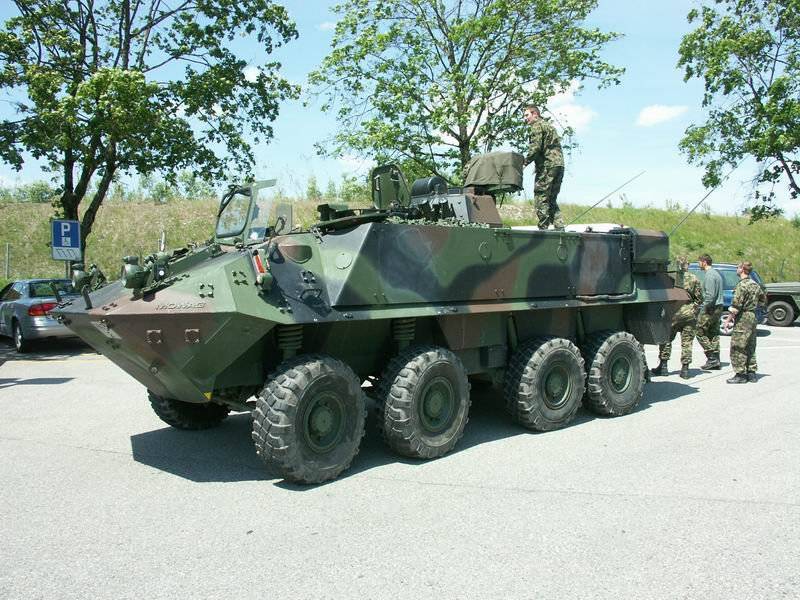
When executing the contract for the supply of armored cars to Saudi Arabia, some difficulties arose, forcing MOWAG to insist on the beginning of licensed production of Pirani in the UK. Most of the armored cars that went to the Middle East were eventually collected there. In preparation for the production of these machines, as already mentioned, the Swiss designers agreed to some extent to refine the proposed machine. Since deliveries for Arabia were not carried out immediately, but in batches, this country regularly put forward updated requirements and wishes, which led to differences among the machines of different batches. Ultimately, such adjustments led to the appearance of a line of armored vehicles, which received the symbol Piranha II.
The design of the four-axle chassis "Piranha II" almost did not differ from the corresponding unit of the original Piranha 8x8. The armament of the updated armored car was taken almost unchanged from the American LAV-25 with the 25-mm automatic cannon. In addition, on the turntable on each side mounted one launcher for anti-tank missiles BGM-71 TOW. At this difference from the original and ended. Most of the amendments to the design concerned only the technological part. Arabians wanted to get a good modern armored personnel carrier and at the same time save on the purchase. In general, one cannot say that such a desire was wrong.
In addition to the armored personnel carriers, Saudi Arabia wished to receive a “wheeled tank” with a 90-millimeter gun. Two guns were considered as applicants for armament of an armored car. The French company GIAT offered its TS-90 turret with an F4 cannon, and the Belgian Cockerill introduced the LCTS combat module with an Mk.9 cannon. As a result of comparing combat characteristics, recoil force and ease of use, a Belgian gun was chosen. One of the main reasons for the loss of the GIAT F4 gun was its excessive power. The high velocity of the projectile became the cause of unacceptably large returns, which did not allow the use of this gun on a relatively light armored vehicle. Supply of wheeled tanks"Started in 1997.
A little later, the customer began to receive Piranha AMS combat vehicles, developed from the beginning of the nineties. Such a long time to create new cars was due, in the first place, to the boldness of the decisions and the originality of the design, which ultimately required spending much more time. The letter index in the name Piranha AMS stands for Armored Mortar System - “Armored mortar system”. For whatever reason, the Arabians did not order these machines from MOWAG, but held a competition to create new weapons for the mortar. Two "unions" of arms manufacturers participated in this competition: MOWAG and Thomson competed with GMC and Royal Ordnance. European firms decided to go in a simple and proven way. Almost all the seats were removed from the troop compartment of the base piranha armored car and installed a turntable with an 120-mm 2R2M mortar, as well as ammunition boxes. It turned out cheap and convenient. American-English cooperation, in turn, went the other way. GMC and Royal Ordnance found the traditional approach to creating a self-propelled mortar unpromising and inconvenient for modernization. They considered the concept applied in the Soviet self-propelled guns Nona-S much more promising. A specially designed tower with a millimeter 120 caliber gun was installed at the site of the Piranha troop compartment. Swiveling combat module allowed directing it around. Since the initial specification required the creation of a self-propelled mortar, the new gun could go up to 80 ° and descend 5 ° from the horizontal. Thus, the Piranha AMS in the version from GMC and Royal Ordnance could fire both on the hinged trajectory and on the flat. For the convenience of loading breech-loading mortar tower equipped with appropriate automation. Thanks to this unit, the maximum rate of fire of the system reached twelve shots per minute. The target equipment of the self-propelled mortar included a set of sensors, a ballistic computer, a laser range finder, etc. The final fighting qualities of the Piranha AMS with the tower turned out to be excellent. Depending on the type of ammunition used, a mortar could hit targets at a distance of up to ten kilometers. Direct shot range - 800 meters. The sighting system provided self-propelled guns very decent accuracy characteristics. So, on probation when shooting at the maximum distance of direct fire "Piranha" with a mortar in the turret, seven shots from eight struck a training target - a tank. Shipments of the order of hundreds of such machines began in the 1998 year.
Piranha III
The next "generation" of Piranha 8x8 armored cars was created for the Swiss armed forces and, unlike previous projects, with their participation. The main customer wanted to get a car with the best characteristics of terrain. To do this, first of all, they replaced the type of tires and finalized the design of wheel hubs. Tires of a slightly smaller diameter at the same time had a relatively large width. New wheels slightly increased the overall width of the car, now this figure was 260 centimeters. It is worth noting, at first this fact caused the claims of the Swiss army - the car came out of the standard dimensions of wheeled vehicles. However, after a trial operation, the military ceased to be indignant and recognized the extra 10-12 centimeters of width as an insufficient reason for refusing to put into service. Later practice showed that such a slight increase in the width of the combat vehicle is almost negligible. New requirements for internal volumes forced MOWAG engineers to increase the length of the machine. From six and a half meters, it grew to 6,9 m. Due to this, the internal net volume increased to nine and a half cubic meters.
For the first time in the Piranha family, the armored car received reinforced armor. Own sheets of the armored case began to withstand the hit of large-caliber armor-piercing bullets, including the KPV machine gun from a distance of up to 300 meters. In the course of further work, it was possible to give the Piranha III an opportunity to use additional reservations. As a result, the frontal projection of the armored car with mounted panels began to protect the crew and units of the vehicle from shells of caliber up to 30 millimeters. The complex of armament of new cars was originally created in a modular scheme.
Initially, the Swiss armed forces planned to order from MOWAG more than six hundred Piranha III combat vehicles in various versions. However, later, for reasons of economic and technical nature, most of the required quantity had to be “covered” with machines of the Piranha II line. The remaining 60 "Pirani III" were made in three versions. This is an armored personnel carrier with a German-made turret KUKA 606А1 armed with an 12,7-mm Browning M2HB machine gun, command-based vehicles based on the BTR and anti-tank armored vehicles armed with M47 Dragon missiles with eight missiles. The crew of all the cars of the third generation consists of only two people. Therefore, for example, in the case of an armored personnel carrier, the commander of the vehicle simultaneously performs the duties of a gunner. In the troop compartment of an armored personnel carrier can accommodate up to ten people. After using the ammunition or unloading the same amount of soldiers can be transported and anti-tank machine.
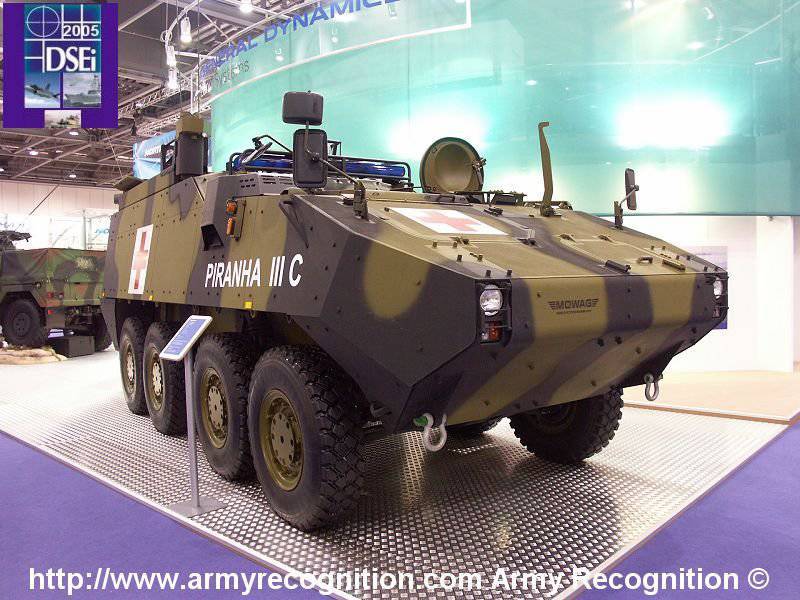
The power plant of the updated "Pirani" was made on the basis of diesel engines with a capacity from 350 to 400 horsepower. Depending on the wishes of the customer, the armored cars can be equipped with engines made by MTU, Scania, Caterpillar, Cummins or Detroit. The engines of the first two companies have the greatest power (400 hp) - these are 6V183TE22 and DSJ9-48A, respectively. A significant increase in engine power installed on the Piranha III, had little impact on speed performance. The previous maximum speed in 100 km / h was more than sufficient, therefore the engine power “went away” to compensate for the increased combat mass and to ensure modernization prospects. The available engine is sufficient to ensure acceptable performance when installing an additional booking and / or other combat module. One of the reasons for the increase in combat mass was the external additional fuel tanks. At regular refueling, the Piranha III can drive 750 kilometers along the highway.
Armored car Piranha III was successful not only in technical terms. In 1998, just three years after the start of supplies for the Swiss army, MOWAG received a profitable order from Denmark. This country wanted to purchase at least 100-110 armored personnel carriers and 18 command and control vehicles. By the middle of the next decade, the order was fully completed. It is noteworthy that in the Danish competition, the Swiss car overtook several European competitors, including the German BTR TPz1 Fuchs. Shortly thereafter, Australia showed its interest in the “third generation”, eventually buying several dozens of such machines.
Simultaneously with the promotion of the new armored car on the international market, MOWAG continued to develop new modifications. For example, attempts were made to install a Piranha AMS mortar tower on the Piranha III, but this combat vehicle did not receive much success. Another interesting project based on the third Piranha, ASV-105, was developed by Canadian GMC in a corporation with General Dynamics Land Systems. An 105-mm rifled gun mounted on an automatic remote-controlled system was mounted on a standard armored hull. With up to forty rounds of ammunition, such a “wheeled tank” had a fairly low combat mass and could be transported by C-130 transport aircraft. Due to the complexity of the creation and operation of an automatic installation for a gun, the ASV-105 combat vehicle also remained a prototype.
Piranha IV
In 2001, it became aware of the existence of a new project of the Piranha family. Another armored vehicle received an even more powerful engine: MTU's 540-powerful diesel. In addition, the fourth "Piranha" received an updated armored corps with the bottom of a characteristic profile, protecting the crew and landing forces from the explosion of mines. The exact characteristics of the Piranha IV are not yet clear - design work is still ongoing. At the same time, several reports have already been received about the desire of some countries to start assembling such armored vehicles under license. His interest in the new car showed the UK and Japan.
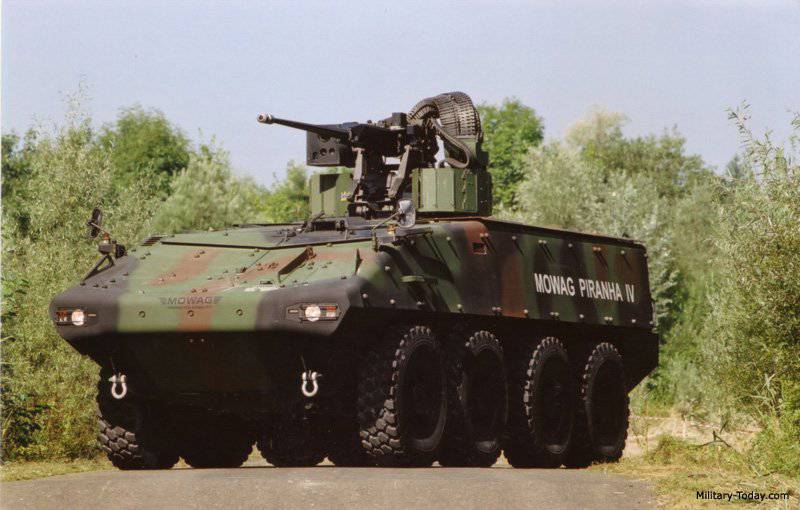
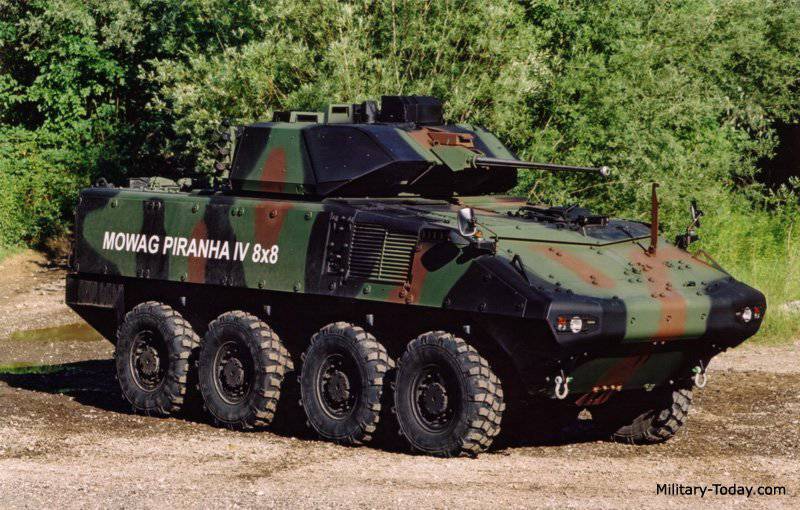
It is known that the Piranha IV combat mass is approximately equal to 24 tons, ten of which fall on the payload or on the combat module. Increased the size of the car. Now the width of the armored car is equal to the 2,8 meter, and the length has increased to 7,25 m. With regard to the number of soldiers transported, the Piranha IV remained at the level of the previous model - a crew of up to three people (depending on the type of weapon) and up to seven people of the assault. The proposed weaponry of the armored vehicle is quite diverse and can have a caliber from 7,62 mm in the case of machine guns to 105-mm guns. In this case, the main focus is on systems equipped with large-caliber machine guns and small-caliber artillery. Turrets and turrets with the M2HB machine gun or 25 and 30 mm cannons are currently offered.
For a number of reasons, the total number of armored vehicles produced by the Piranha IV line does not yet exceed one and a half to two dozen. Basically, these are prototypes of combat vehicles with various weapons. Negotiations on the supply are not the first year, but so far there have been no firm orders.
Piranha v
The latest at the moment version of the four-axis "Piranha" has a serial number "V". This project began in the mid-2000s, shortly after MOWAG became a division of General Dynamics. It is noteworthy that almost simultaneously with the acquisition of the Swiss company, the concern General Dynamics took over General Motors Canada. Thus, at present, all work on the development of the Piranha family, de jure, is carried out by the same large company.
Unfortunately, there is even less information on the Piranha V project than on the previous car. To date, it is known that the new "Piranha" has approximately the same appearance as the fourth armored car of the family, but much larger in size. Now the maximum length of the armored hull is eight meters, and the width slightly shortens up to three. The Piranha V armament complex is generally similar to previous designs. The same can be said about the power plant and characteristics. According to the stated data, it is clear that the main emphasis in developing the fifth Piranha is on the level of protection. The armored hull meets the requirements of the fourth level of the STANAG 4569 standard: it withstands hit of 14,5 caliber bullets from all angles and protects the crew from undermining 10-kilogram land mines under the wheel or under the bottom.
It is known that several countries have already shown their interest in a promising multi-purpose vehicle. In this case, full negotiations on the sale so far were conducted only by Canada. It is possible that armored cars for this country will be assembled at factories previously owned by GMC, where LAV had previously been assembled.
Piranha 10x10
As if following a certain tradition, in 1992, the company MOWAG continued to increase the number of wheels of its armored vehicles and began the project Piranha 10x10, which involved the creation of a five-axle (!) Fighting vehicle. Twenty years have passed since then, but no other armored vehicles with the same or similar undercarriage have yet appeared. As a matter of fact, the Swiss engineers eventually also came to the conclusion that the fifth axis is redundant and useless. Just two years after the start of the design work, the first prototype came out for testing. Eighteen-ton machine had a body length of about 7,2 meter and was equipped with a gun turret. The design of the armored vehicle was based on the developments of the Piranha II project, which affected the level of protection. At the same time, the frontal part was slightly strengthened and began to withstand 14,5-mm bullets. Interesting chassis ten cars. The first four wheels have a spring suspension and are manageable. The remaining six are equipped with torsion bar suspension. The “default” drive is only three rear axles, but if necessary, the driver can turn on the power transmission to the front wheels.
On the first prototype, the French tower GIAT TML-105 was installed with a G2 cannon of 105 caliber of millimeters. This gun had a good firing performance: the initial speed of the sabot projectile is approximately equal to 1500 m / s. Next to the gun installed coaxial machine gun rifle caliber. The gun ammunition included 38 shells, 12 of which were placed in the tower. In addition to the powerful weapon, the Piranha 10x10 armored car could carry a wide range of weapons, generally similar to the previous Piranhas.
The first new "wheeled tank" interested in the military of Saudi Arabia. They responded well to the characteristics of the car, but in the future they preferred the eight-wheeled armored car of the previous model. The fact is that the five-axle Piranha turned out to be significantly more expensive than the four-axle. In this case, any serious advantages in driving performance or maneuverability "Piranha 10x10" did not have. The project was under threat of closure. From the sad fate of the new armored car rescued the Swedish military. The army of the Scandinavian country in the mid-nineties ordered 33 such machines. Most of the armored vehicles ordered carry heavy weapons, while the rest are equipped with communications and control equipment. The entire Swedish order was completed at the beginning of the two thousandth years and more than ten-wheeled “Piranhas” were not produced. Moreover, the entire direction of such a monstrous technique was curtailed. After completing the Swedish order, MOWAG considered the possibility of continuing the work, but the Piranha 10x10 project remained a technical curiosity, which managed to go into a small series.
On the materials of the sites:
http://mowag.ch/
http://army-technology.com/
http://warwheels.net/
http://vadimvswar.narod.ru/
Nikolsky M.V., Ilyin V.E. Wheel armored vehicles. - M .: Astrel / AST, 2001
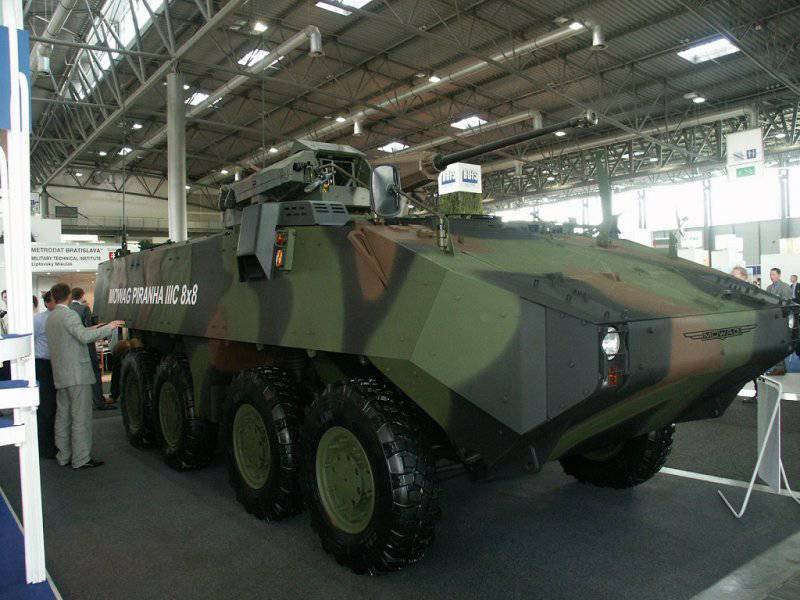
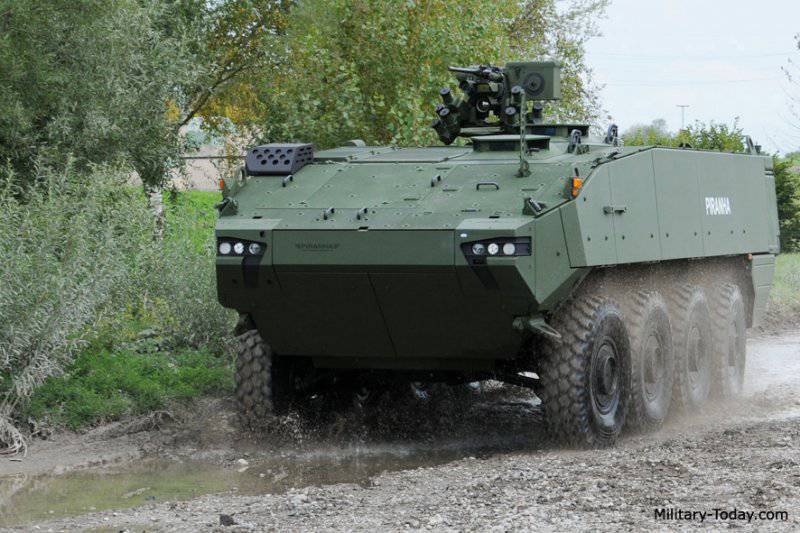
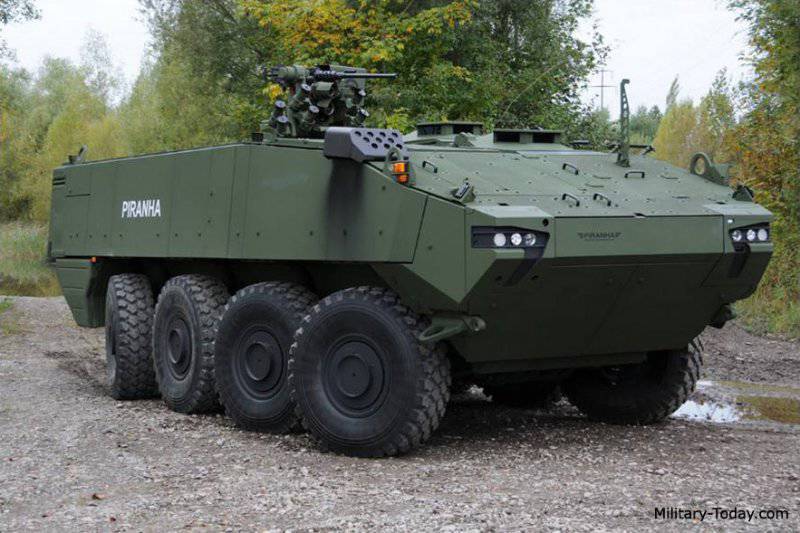
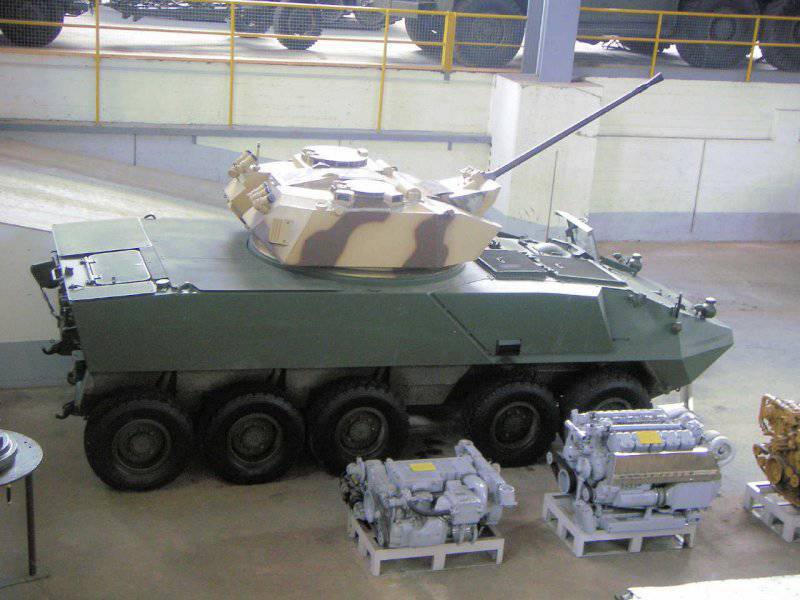
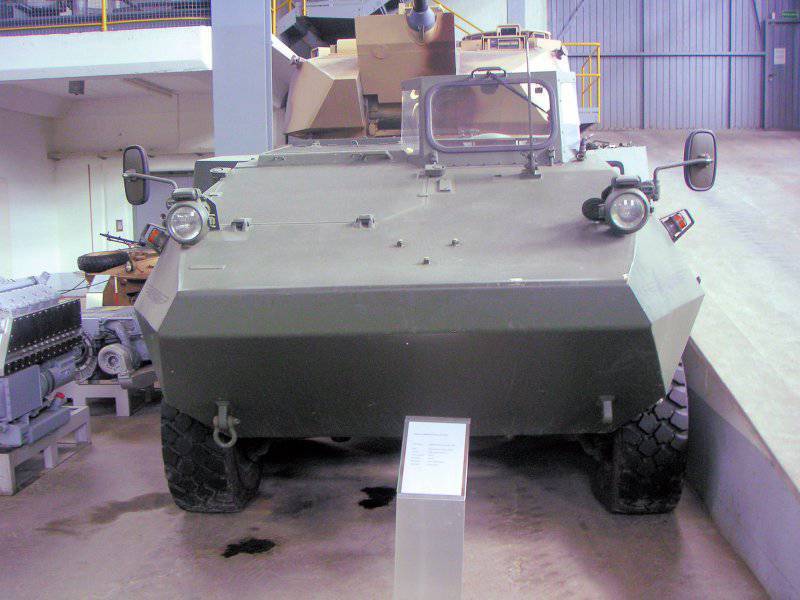
Information